Can Fracking Lead the Way To Clean Energy? A Promising Geothermal Technology Just Might Do the Trick
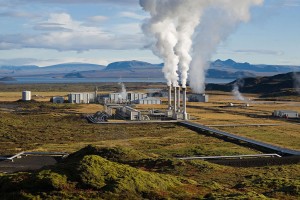
THERE’S A PROVERB often attributed to Euripides that warns: “Whom the gods would destroy, they first make mad.” Ellen Harrison knows what the ancients were on about. In 2008, in a moment of what she now calls madness, the retired environmental scientist signed a lease to allow drilling on the fifty acres of land she and her husband own. She’s been fighting mad ever since.
After Harrison retired from Cornell University six years ago, the couple moved onto a beautiful acreage in upstate New York. Soon after they were approached by representatives of an exploration company who offered what seemed like a sweet deal. “Rick and I signed a gas lease,” she admits. “We didn’t know about fracking.”
Hydraulic fracturing, known as fracking, is a method of extracting trapped gas and petroleum by injecting water, sand, and chemicals underground to fracture the deep rocky layers. When Harrison first learned about the destruction fracking can inflict on rural communities and the threat it poses to the water supply, she went into shock. “I didn’t sleep for three nights,” she recalls, “and I’m a good sleeper.”
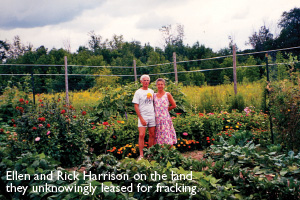 Soon after, Harrison took action. She formed a group called Fleased to educate others and organize against what she saw as unfair and deceptive practices in the fracking industry.
Soon after, Harrison took action. She formed a group called Fleased to educate others and organize against what she saw as unfair and deceptive practices in the fracking industry.
As a result of public pressure, in July 2008 the State of New York imposed a moratorium on fracking. Since then Fleased and other groups have spurred the passing of permanent bans on fracking in numerous townships. An industry lawsuit against nearby Dryden challenging its municipal ban will soon be heard by New York’s highest court.
In the meantime Harrison shouldn’t feel too bad. When it comes to usable power, the figurative energy gods have long made Americans more than a little crazed. From the coal-fired beginnings of the Industrial Revolution to the oil boom of the late nineteenth century, fossil fuels at once raised living standards and lowered ethical ones, leading to the Gilded Age when children were worked to death in the mines while the likes of John D. Rockefeller and Henry Clay Frick bought themselves congressmen by the batch.
Way down in the underworld, Hades would certainly snicker. In a shift of unprecedented irony, we seem as a nation to be moving from coal crazy to gas mad. But one person has a proposal that may yet restore sanity to our energy policy.

Jimmy Randolph (© Randolph 2013)
Jimmy Randolph grew up in rural Minnesota and professes a deep love of the land. As a scientist he knows that climate change is the overarching challenge we face. “I’m fairly young, and I have a young family,” he told me. “We need to go down a different road and soon.” But he also recognizes that civilization needs affordable energy. Preaching green just won’t solve the problem. A study published in Nature Climate Change last year found that people won’t degrade their present standard of living for a hazy hope of averting climate disaster—especially if they perceive that others will evade the sacrifice.
“Romance doesn’t get us anywhere,” Randolph says. “The solution needs to be commercially viable—no government subsidies, no green drivers, just commercial interest.” Pursuit of that goal has shaped his career. Together with his University of Minnesota dissertation supervisor, Dr. Martin O. Saar, Randolph has come up with a way to redirect the technology developed for fracking into a truly clean, green, and large-scale supply of energy.
Here’s how he sums it up in his doctoral dissertation: “This new approach represents a radical shift in electric/heat power generation as it not only utilizes a renewable energy source but has a negative carbon footprint.” Got that? A negative carbon footprint! What could possibly provide boundless energy while absorbing carbon dioxide? Could it be Hades itself?
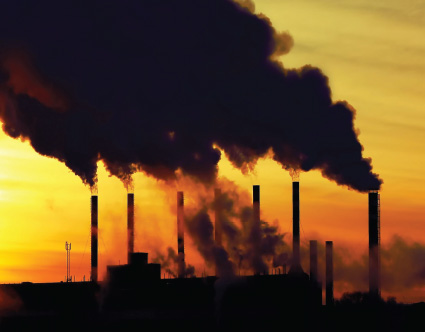
© mihtiander | 123rf.com
FOR DECADES environmentalists have aimed their boos and hisses at coal-fired generation plants as the leading villains in the pageant of climate polluters. Their censure is well directed. More than 83 percent of greenhouse gas emissions are in the form of carbon dioxide (CO2), and no one produces more of it than electric power plants.
When we think of emissions, most of us picture endless lines of cars and trucks pumping out exhaust in rush-hour traffic. That’s bad, but it’s far from the worst. The Environmental Protection Agency (EPA) estimates that U.S. power plants, in burning fossil fuels to power their turbines, emit 24 percent more CO2 than the entire transportation sector. Most of that comes from the burning of coal.
Now, at long last, the EPA is slouching toward regulation of greenhouse gas emissions from coal-fired plants. At public hearings in the Midwest, angry citizens are turning out to demand the agency keep its hands off their cheap, coal-based electricity. Lawsuits are forcing the closure of some existing plants. At the same time the Obama Administration has declared an end to U.S. support for coal-fired electricity projects abroad.
You can almost hear the Greek chorus chortling. Coal use is plunging—not because of a crisis of conscience or the fear of regulation, but because suddenly, unexpectedly, another fossil fuel has become abundantly and cheaply available.
In principle, natural gas is a more climate-friendly fuel than coal. Faint praise—still, it must be noted that when completely burned, natural gas yields about half as much carbon dioxide as coal.
But here’s where the chorus breaks into belly laughs. Incomplete burning can release methane into the atmosphere. Methane is a heavyweight greenhouse gas, with more than twenty times the heat-trapping potency of CO2. Even then, incomplete burning is of minor concern compared with sourcing.
As Ellen Harrison learned, the hot new way to extract natural gas is by fracking. To some, it’s a miracle: no longer must we depend on Middle East oil. Yet more amazing, the United States is expected to overtake Saudi Arabia in fossil fuel production before the decade is out. Speaking on 60 Minutes, the CEO of one of the largest fracking companies, Chesapeake Energy’s Aubrey McClendon, claimed that studies show the gas-bearing shale under U.S. soil holds “the equivalent of two Saudi Arabias of oil.”
For a nation once humiliated by OPEC-led oil embargoes, all this has led to a good deal of crowing. In an online commentary, energy authors Peter C. Glover and Michael J. Economides drop a modified “F” bomb on Saudi Arabia: “OPEC is fracked,” they write at the Commentator. “Plainly, the days when OPEC could hold the West to political ransom—as it did when it ordered an oil embargo after the U.S. supplied Israel with arms during the 1973 Arab-Israeli War—are over.”
But what price prosperity? Those who focus on the environmental consequences view fracking rather differently: that in pursuit of hydrocarbons, we reach down into Hades and dredge up hell.
It’s not just the vast amounts of water that are required, or the chemicals that are added to it. As West Virginia residents learned in January, when their water supply was contaminated by the leak of a mysterious compound known as MCHM into the Elk River, there are virtually no regulations on the storage of chemicals. To be sure, some of the chemicals used in fracking, such as benzene, are known carcinogens. But when water is pumped back up from deep underground, it can bring all sorts of additional contaminants up with it.
Under the enormous pressures involved in fracking, toxic metals and minerals may be brought to the surface—or worse, leak into the water table just below ground. At least two studies (one out of the University of Texas at Arlington published last summer in Environmental Science & Technology and another conducted by the EPA in 2009) have found elevated levels of arsenic in water supplies near fracking sites. Radioactive elements, too, can make their way topside. Shifting all that stuff can destabilize the strata. As fracking has taken hold in Oklahoma, the number and intensity of earthquakes in the Sooner state have skyrocketed. The industry insists that it takes precautions to contain all the hazards. But with millions of gallons of water—and tens of thousands of gallons of chemicals—used in every frack, accidents are inevitable.
Even when best efforts are made to contain the wastewater, nature can intervene. Colorado learned this last September, when raging floodwaters caused thirteen major spills of fracked oil and the chemicals associated with it—at least 45,000 gallons in all. Fracking’s defenders point out that a great deal more sewage was released in the floods, but that hardly counts as evidence that fracking is safe.
Then there’s air pollution to consider. In Wyoming, the least populated state in the Union, a plunge in air quality has been recorded since the fracking boom began. Between the nonstop trucking and the burning of gas at wellheads, Wyoming’s air pollution at times exceeds that of Los Angeles and is way beyond the EPA’s safe limits for ozone.
For Harrison, the socio-environmental effects of fracking are almost as scary. Fracking, she says, turns a rustic community into an industrial wasteland. Roads are built or widened to accommodate trucks. Industry structures dot the landscape.
“There is phenomenal truck traffic,” she notes. And with it come itinerant workers, often young men who descend on the community, work hard, earn cash, then go out looking for a good time, and often find trouble. Rents soar. Crime rises. When the wells turn less productive, they all move on. The boom-and-bust cycle fracking brings on “just wrecks the social fabric,” Harrison says.
Sometimes, though, local degradation must be accepted for a broader societal benefit. If there were no mines, for example, there would be no civilization. So, if fracking for natural gas instead of mining coal cuts our greenhouse gas output, the global improvement might justify the local impact.
Is that the case? Not exactly. While coal undoubtedly produces more CO2, there are conflicting reports on the amounts of methane that leak from fracking. The optimistic case is made in a University of Texas study published in September in Proceedings of the National Academy of Sciences. It found that methane leakage from fracking wells was 20 percent less than the EPA’s working estimate.
However, just two months later another study published in the same prestigious journal found that U.S. methane emissions are much higher than EPA estimates—50 percent higher overall and roughly five times as high in the south-central region, including Texas, where a good deal of fracking occurs. However, the study was unable to cleanly disentangle the methane contribution of livestock from that of gas-and-oil operations, so uncertainty remains.
Does it all boil down to gas versus coal? Both are fossil fuels, and burning either contributes to climate change. So why not just switch to renewables?
IF THERE’S ONE THING our energy policy has proven, it’s that switching to renewables is easier said than done. Nearly forty years after Jimmy Carter declared our energy crisis “the moral equivalent of war,” electricity from solar amounts to less than 1 percent of that from coal. Wind adds a measly five kilowatts to the grid for every 100 generated by coal. Decades-old dams do better than that.
Beyond doubt, stop-and-go U.S. energy policies have added to the difficulties. But a fundamental difficulty has been the focus on solar and wind. They are emblems of green energy. Ken Winston, an attorney for the Sierra Club, says the time is ripe for making the switch. “The prices for wind and solar have gone very low,” he said in an interview for this story. “The price of wind generation is now comparable to old-[fashioned] fossil generation.”
Sure, the cost of wind power has come down, while the cost of coal-fired generation has gone up. Solar has become more efficient and less costly. But the sober truth about wind and solar is that they are by nature supplemental energy sources. Try scaling them up, and all sorts of problems emerge.
Russ Baker, manager of the Environmental & Regulatory Affairs Division of the Omaha Public Power District, one of the Midwest’s major coal-burning utilities, seems enthusiastic about expanding his company’s renewables portfolio. “In 2014 a little over 14 percent of our power will be generated by wind,” he told me. “By 2015, close to 30 percent will be wind.”
Unlike many electricity producers, OPPD is owned by the public, which means it doesn’t have to put profit ahead of public interest. Baker insists that his utility wants to diversify its fuel base and sees its plans to aggressively boost its investment in renewables as the best way to serve its customers. But replace all its coal-fired generators with wind? That gives him pause.
Wind is intermittent. Even in a state that brags about being “the Saudi Arabia of wind,” Baker says the utility can only bank on getting half the capacity of its wind turbines at any one moment. “You take away 2,000 megawatts of coal-fired power,” he says, “and I’m going to need 4,000 megawatts of wind, and even that isn’t going to be completely reliable.”
Wind power may be clean, but it’s not entirely green. Whirling turbines make avian guillotines, for one. Duke Energy recently agreed to pay a $1 million fine for killing birds, including endangered golden eagles, with its wind generators in Wyoming.
In Germany, where lawmakers have mandated a swift march toward renewables, the attempt to vault into clean energy has sparked a crisis. “German families are being hit by rapidly increasing electricity rates,” the New York Times reported last fall, “to the point where growing numbers of them can no longer afford to pay the bill.”
Feeding electricity from a string of wind turbines into a grid built to draw from large-scale generation plants is tricky. “If all of them are spinning at once you have an overabundance of power,” says OPPD’s Baker. “Conversion to wind is not so easy.” Apart from surges and slumps, he notes, a widely spread array of wind turbines presents utilities with complex transmission issues.
That may be one reason Germany’s North Sea wind farm remains, as of this writing, unconnected to its grid. Meantime, though, Germany has cut the ribbon on new coal-fired generating stations. The nation’s carbon emissions are actually rising, though the green-leaning government of Angela Merkel promises that the trend will reverse.
As for solar, utility-scale generation is a nonstarter in most of the world. The life cycle costs are still well above those of fossil fuel generation, and the capacity factor is worse than wind. Even with clear skies in the summer, the sun is overhead no more than a third of the day. Come winter in a place like Nebraska, and Ol’ Sol loafs around in the southern skies while ice and snow obscure the solar panels.
Worse yet, improved efficiency in solar technology has come through the use of rare metals such as gallium, already in demand for cell phones, flat panel TVs, and LEDs. And let’s not even talk tellurium. An analysis of solar power limitations by the National Renewable Energy Laboratory finds that hefty prices for this rare but crucial material “already contribute significantly to module cost, and future price could be a critical issue to the economic viability” of solar technology. Scale up photovoltaic to replace the nation’s coal plants, and the costs would go through the solar-paneled roof.
IF WIND AND SOLAR can’t replace coal-fired generation plants, what can? Hydropower, in principle. It already supplies nearly 9 percent of the nation’s electricity. A large hydroelectric dam can easily outmuscle a coal-fired plant. Indeed, the world’s largest power plant, with a capacity of 22,500 megawatts, is China’s Three Gorges hydroelectric station. That’s well over ten times the output of a typical coal-fired station.
So should we say, dam it all? Not really. Even if the remaining potential for hydropower were fully exploited, according to the EPA, the sector could grow by no more than a third, and it could not be done without damaging riparian ecosystems already under stress.
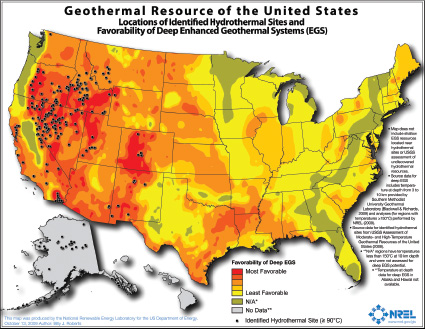
This map was created by the National Renewable Energy Laboratory for the U.S. Department of Energy.
We are left with two viable choices: nuclear and geothermal. There are nuclear designs worth consideration—in particular, the self-regulating liquid fluoride thorium reactor. LFTRs are designed to make use of radioactive thorium and uranium dissolved in liquid fluoride salts. Among their many advantages over conventional power plants is that in the unlikely event that the fuel overheats, it melts a safety valve and then drains into a safety container below, shutting down the reactor without the need of human intervention or external power. But with damaged conventional reactors at Fukushima still spewing radioactive water into the sea, public opposition strikes many experts as an insurmountable hurdle. That brings us to geothermal. The use of Earth’s latent heat energy isn’t exactly new. Roman nobles drew on hot springs at Pompeii to run heated water under the floors of their mansions. Several millennia later in 1892, Boise, Idaho, followed suit by piping scalding water from hot springs to municipal buildings and homes. In 1922 the first U.S. geothermal power plant went online at The Geysers, just north of San Francisco.
Ever since, geothermal generation projects have sprung up over hot spots. Recently, a company called AltaRock has been drilling into an Oregon volcano to tap its heat. While this makes sense, it also marks a serious limitation. Virtually all the high-heat resources accessible with current technology in the United States lie under the Western states, as shown above. The vast majority of coal-fired plants (below) are in the Midwest and East.
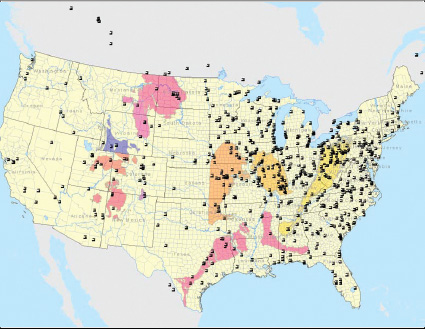
This image is provided by the U.S. Department of Energy’s National Energy Technology Laboratory
“Ha, ha,” snarks the Olympian chorus, “you lose.” But here is where the plot turns on a monumental irony: technologies developed for fracking have opened up new and evidently safer possibilities for geothermal. Collectively, they are known as enhanced geothermal systems, or EGS.
Among the many good ideas in EGS, none holds more promise—or irony—than Jimmy Randolph’s. His concern about climate change led him to focus on conventional geothermal energy as a doctoral student. Then a detour into research on how to get carbon dioxide out of the atmosphere by pumping it far below the surface brought him to a kind of Reese’s chocolate-meets-peanut-butter moment: why not cross geothermal know-how with CO2 sequestration?
The big idea that he and Saar, his academic supervisor, developed was to take the very stuff of global warming and use it as the medium for electric generation. “We found that CO2 makes a lot of sense as a geothermal liquid,” says Randolph.
Their patent application for what they term a “carbon plume geothermal” system outlines some of its advantages: “[G]eothermal energy can now be provided at lower temperatures and at locations other than hot, dry rock formations, without negatively impacting the surrounding area through use of large-scale hydrofracturing.”
That last point should be triple underlined. Carbon dioxide does not require fracking-type injection pressures to work in this system. But the issue is not pressure alone. Fracking brings up contaminants for two reasons: first, its “slick” water is formulated to sweep hydrocarbons—and anything else—to the surface, and second, it is injected at pressures of up to 15,000 pounds per square inch. That’s equivalent to the pressure at the bottom of the Mariana Trench in the deepest depths of the ocean. No wonder fracking pulverizes anything in its path. By contrast, says Randolph, their carbon plume system “requires no more than half the level of pressure required to cause fracturing.”
What’s more, he says they don’t have to pump it back up. Once heated deep underground, the plume forms naturally, like a gently shaken bottle of soda pop. “CO2 essentially fizzes back up in a dense form, where we can capture it in a production well.”
Even better, CO2 is unlikely to contaminate drinking supplies. “The actual working zone is thousands of feet beneath the water table,” Randolph explains. The patent calls for making use of permeable zones located beneath caprocks. Unlike drilling sites for fracking, entry and exit wells would be designed to last decades. “Any good system has to be closed loop,” he contends. “Everything you bring up goes back down.”
Maria Richards, director of the geothermal lab at Southern Methodist University, confirms that geothermal wellheads are superior.
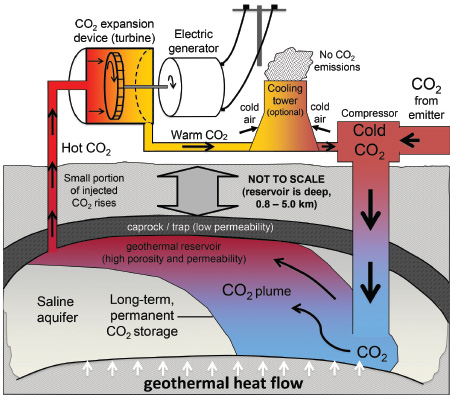
© Randolph and Saar 2013
The typical life cycle investment for any electricity project is at least three decades, she notes. “To make a well that will last that long, you have to have thick casing in the borehole throughout the upper zones. The concrete needs to last thirty years.”
Asked for an independent assessment of Randolph and Saar’s system, Richard Kettler, professor of geology at the University of Nebraska-Lincoln, says he finds it plausible. For starters, the system is designed to work in locations with sedimentary rather than volcanic beds deep underground. “There are far more areas that would be favorable for this technology, and that gives you a lot of freedom,” he notes. A “geologically optimal” site for a CO2 system is much more likely to be found under the coal-fired stations that dot the Midwest than conventional geothermal, which must seek out hot spots in the West.
Kettler finds the claims about a “carbon plume” rather credible. “Carbon dioxide has a very low viscosity,” he explains, “so you’re likely to be able to recover it” from underground without much effort. What’s more, when it returns to the surface, it’s not likely to be contaminated with a lot of undesirable minerals. “Water really is the universal solvent,” he says. “It dissolves everything in sight.” Carbon dioxide, by contrast, likes to keep to itself.
The one big question in Kettler’s mind is whether a high enough geothermal gradient exists underground to power massive electric generators. Randolph believes that in many locations CO2 will bubble up plenty hot. But even where that’s not true, Kettler says, the system could prove useful for heating homes and other applications.
STILL, the most exciting possibility by far is to drill next to existing coal-fired generators and convert them to geothermal. Randolph says he would love to “bolt on to a power plant.” Indeed, at the Heat Mining Company, a spin-off where he now serves as chief technical officer, they have plans to do just that… after they help the gas and oil industry become more efficient (the irony rolls on).
“Bolting on” would mark a huge strategic swing. Until now geothermal projects have always been purpose-built over hot spots. But Randolph and Saar’s studies suggest that CO2 can effectively drive a generator if heated to just 60 degrees centigrade—below the boiling temperature of water. That kind of heat is available just about everywhere at a depth of two to five kilometers.
Now, drilling to that depth isn’t easy, but frackers do it all the time. What’s more, the cost of drilling has fallen by about half as new techniques and efficiencies have been found. One thing is for sure: the cost of drilling a geothermal site next to an existing coal-fired plant would be trivial compared with building a new power plant.
Precise comparisons at this stage are impossible, but the scale of difference is so large that precision doesn’t matter. For example, to drill a three-kilometer-deep fracking well with a 1.2 kilometer horizontal extension in the United States costs about $8 million according to Ken Medlock, senior director at Rice University’s Center for Energy Studies. The cost of a single coal-fired unit built in 2006 by Duke Energy was estimated at $1.5 billion, nearly 200 times as much.
As if price differential were not enough, lawsuits are forcing utilities to shut down a growing number of their coal-fired plants, and regulations stand squarely in the way of building new ones. OPPD’s Baker says the new EPA regulations expected to take hold in 2014 “will make it very, very difficult to build a new coal-fired plant.”
The subterranean gods might smirk to see Randolph’s idea make fracking more profitable, but if it goes the way he hopes, humanity will have the last laugh. Here’s why: once drilling next to coal-fired plants becomes not only a viable but a profitable way to keep the turbines turning, then going the next step to sequester all the CO2 the plant produces becomes an affordable add-on.
What’s more, although CO2 will try to bubble up to the surface, it can be managed. Think again of a shaken bottle of pop. If you put your thumb over the top, you can not only increase the pressure of the stream but keep some of the soda in the bottle. Recent research highlighted in Scientific American’s “World Changing Ideas of 2013” suggests that if the geothermal system regulates its carbon plume, the surplus CO2 pumped below the caprock will gradually form carbonate, a rocky compound that should stay put indefinitely.
So, who will put the theory to the test? Recently, MidAmerican Energy, a major utility owned by Warren Buffett’s investment company, entered into a settlement after the Sierra Club sued it over the pollution emitted by its Walter Scott Energy Center near Council Bluffs, Iowa. Under the settlement, the utility will shut down two of its four coal-fired turbines there (along with several others at different locations), no later than April 2016.
Would it be worth trying to restart them with CO2? The remaining turbines could certainly supply plenty of CO2—though the flue gas they produce would have to be run through carbon-capture equipment. The sedimentary strata under the plant may well be suitable, though that hasn’t yet been confirmed. If successful, the conversion would likely give a huge boost to MidAmerican’s corporate image. Though the company declined to comment for this story, Jimmy Randolph would love to hear from them.
Will they take a chance on some doomed turbines? They’d be mad not to try. ![]()
